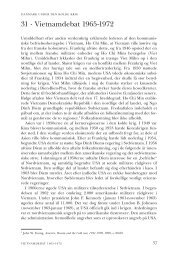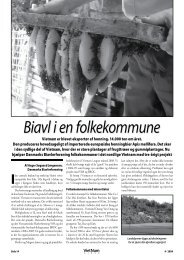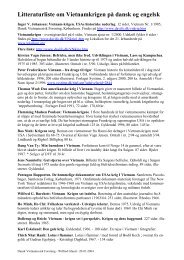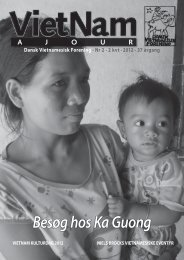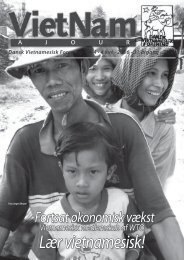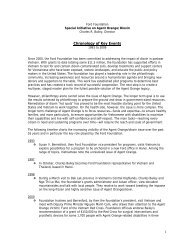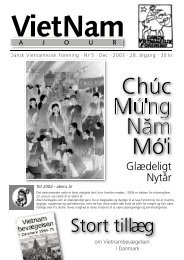Food as a Source of Dioxin Exposure in the Residents of Bien Hoa ...
Food as a Source of Dioxin Exposure in the Residents of Bien Hoa ...
Food as a Source of Dioxin Exposure in the Residents of Bien Hoa ...
You also want an ePaper? Increase the reach of your titles
YUMPU automatically turns print PDFs into web optimized ePapers that Google loves.
JOEM • Volume 45, Number 8, August 2003 781FAST TRACK ARTICLE<strong>Food</strong> <strong>as</strong> a <strong>Source</strong> <strong>of</strong> <strong>Diox<strong>in</strong></strong> <strong>Exposure</strong> <strong>in</strong> <strong>the</strong><strong>Residents</strong> <strong>of</strong> <strong>Bien</strong> <strong>Hoa</strong> City, VietnamArnold Schecter, MD, MPH<strong>Hoa</strong>ng Trong Quynh, MD, PhDMarian Pavuk, MD, PhDOlaf Päpke, MSRa<strong>in</strong>er Malisch, PhDJohn D. Constable, MDRecently, elevated diox<strong>in</strong> levels, over 5 parts per trillion (ppt) 2,3,7,8-tetrachlorodibenzo-p-diox<strong>in</strong>(TCDD), from Agent Orange w<strong>as</strong> reported <strong>in</strong> 95% <strong>of</strong> 43 selected residents <strong>of</strong> <strong>Bien</strong> <strong>Hoa</strong> City, a city <strong>in</strong>sou<strong>the</strong>rn Vietnam near a former air b<strong>as</strong>e used for Agent Orange-spray<strong>in</strong>g missions. Agent Orangeherbicide, contam<strong>in</strong>ated with TCDD, w<strong>as</strong> sprayed <strong>in</strong> Vietnam between 1962 and 1971 primarily for use<strong>as</strong> a defoliant. Typical blood TCCD levels are 2 ppt <strong>in</strong> Vietnamese, but levels are <strong>as</strong> high <strong>as</strong> 413 ppt <strong>in</strong><strong>Bien</strong> <strong>Hoa</strong> City. Elevated TCDD w<strong>as</strong> found <strong>in</strong> children born many years after Agent Orange spray<strong>in</strong>gended and <strong>in</strong> immigrants from non-Agent Orange-sprayed parts <strong>of</strong> Vietnam, which documented newexposures. Extremely elevated soil TCDD samples, over 1 million ppt, and elevated TCDD <strong>in</strong> sediment werefound <strong>in</strong> some nearby are<strong>as</strong> such <strong>as</strong> <strong>Bien</strong> Hung Lake. The primary route <strong>of</strong> <strong>in</strong>take <strong>of</strong> almost all diox<strong>in</strong>s<strong>in</strong> humans is food. However, <strong>in</strong> our prior studies <strong>in</strong> <strong>Bien</strong> <strong>Hoa</strong>, food w<strong>as</strong> unavailable for diox<strong>in</strong> analysisso <strong>the</strong> route <strong>of</strong> <strong>in</strong>take w<strong>as</strong> not confirmed. In <strong>the</strong> 1970s, while Agent Orange w<strong>as</strong> still be<strong>in</strong>g sprayed, elevatedhuman milk TCDD levels <strong>as</strong> high <strong>as</strong> 1850 were detected <strong>in</strong> milk from Vietnamese people liv<strong>in</strong>g <strong>in</strong> AgentOrange-sprayed are<strong>as</strong> where consumption <strong>of</strong> fish w<strong>as</strong> high. Fur<strong>the</strong>rmore, also <strong>in</strong> <strong>the</strong> 1970s, elevated TCDDlevels (up to 810 ppt) were found <strong>in</strong> fish and shrimp from <strong>the</strong> same area <strong>as</strong> <strong>the</strong> milk donors. In <strong>the</strong> 1980s,we found elevated TCDD and also o<strong>the</strong>r organohalogen levels <strong>in</strong> human tissue, pork, fish, a turtle, anda snake <strong>in</strong> Sou<strong>the</strong>rn Vietnam. For <strong>the</strong>se re<strong>as</strong>ons, we recently collected food from <strong>Bien</strong> <strong>Hoa</strong> and analyzed itfor diox<strong>in</strong>s, polychlor<strong>in</strong>ated biphenyls (PCBs), DDT and its metabolites, and o<strong>the</strong>r organochlor<strong>in</strong>es. Wefound marked elevation <strong>of</strong> TCDD, <strong>the</strong> diox<strong>in</strong> characteristic <strong>of</strong> Agent Orange, <strong>in</strong> some <strong>of</strong> <strong>the</strong> food products,<strong>in</strong>clud<strong>in</strong>g ducks with 276 ppt and 331 ppt wet weight, chickens from 0.031–15 ppt wet weight, fish from0.063–65 ppt wet weight, and a toad with 56 ppt wet weight. Usual TCDD levels <strong>in</strong> food are less than0.1 ppt. Total TEQ for ducks w<strong>as</strong> from 286–343 ppt wet weight or 536 ppt and 550 ppt lipid; for chickensfrom 0.35–48 ppt wet weight or 0.95–74 ppt lipid, for fish from 0.19–66 ppt wet weight or 3.2 ppt and15,349 ppt lipid, and <strong>the</strong> toad w<strong>as</strong> 80 ppt wet weight and 11,765 ppt lipid. Interest<strong>in</strong>gly, this study didnot f<strong>in</strong>d elevated levels <strong>of</strong> TCDD <strong>in</strong> <strong>the</strong> pork and beef samples. Clearly, food, <strong>in</strong>clud<strong>in</strong>g duck, chicken, somefish, and a toad, appears responsible for elevated TCDD <strong>in</strong> residents <strong>of</strong> <strong>Bien</strong> <strong>Hoa</strong> City, even though <strong>the</strong>orig<strong>in</strong>al Agent Orange contam<strong>in</strong>ation occurred 30–40 years before sampl<strong>in</strong>g. Elevated levels <strong>of</strong> PCBs andDDT and its metabolites were found <strong>in</strong> some food samples. Fur<strong>the</strong>rmore, me<strong>as</strong>urable levels <strong>of</strong> hexachlorocyclohexanes(HCH) and hexachlorobenzene (HCB) were found <strong>in</strong> a wide range <strong>of</strong> me<strong>as</strong>urable levels. All<strong>of</strong> <strong>the</strong> 11 diox<strong>in</strong>-like PCBs me<strong>as</strong>ured and presented plus 6 diox<strong>in</strong>s <strong>in</strong> addition to TCDD and 10dibenz<strong>of</strong>urans contributed to <strong>the</strong> total diox<strong>in</strong> toxicity (TEQ). However, when elevated, TCDD frequentlycontributed most <strong>of</strong> <strong>the</strong> TEQ. Thirty-six congeners from 7 cl<strong>as</strong>ses <strong>of</strong> chemicals were me<strong>as</strong>ured <strong>in</strong> each <strong>of</strong> <strong>the</strong>16 specimens provid<strong>in</strong>g a total <strong>of</strong> 576 congener levels. (J Occup Environ Med. 2003;45:781–788)From <strong>the</strong> University <strong>of</strong> Tex<strong>as</strong> Houston School <strong>of</strong> Public Health, Dall<strong>as</strong>, Tex<strong>as</strong> (Dr Schecter, DrPavuk); <strong>the</strong> Center for Cancer Research, Hanoi, Viet Nam (Dr Quynh); ERGO Research Laboratory,Hamburg, Germany (Dr Päpke); <strong>the</strong> State Institute for Chemical Analysis <strong>of</strong> <strong>Food</strong>, Freiburg, Germany(Dr Malisch), and Harvard Medical School, Boston, M<strong>as</strong>sachusetts (Dr Constable).Address correspondence to: Arnold Schecter, MD, MPH, University <strong>of</strong> Tex<strong>as</strong> Houston School <strong>of</strong>Public Health, Dall<strong>as</strong> Regional Campus, 6011 Harry H<strong>in</strong>es Blvd., Room V8.112, Dall<strong>as</strong> TX 75390;E-mail: arnold.schecter@utsouthwestern.edu.Copyright © by American College <strong>of</strong> Occupational and Environmental Medic<strong>in</strong>eDOI: 10.1097/01.jom.0000085786.50835.71Agent Orange, a phenoxyherbicidemixture <strong>of</strong> 50% 2,4-dichlorophenoxyaceticacid (2,4-D) and 50%2,4,5-trichlorophenoxyacetic acid(2,4,5-T), w<strong>as</strong> used dur<strong>in</strong>g <strong>the</strong> Vietnamwar by <strong>the</strong> U.S. military todefoliate jungles where enemytroops could hide and to destroy foodcrops. The herbicide w<strong>as</strong> contam<strong>in</strong>atedby <strong>the</strong> most toxic <strong>of</strong> <strong>the</strong> chlor<strong>in</strong>ateddiox<strong>in</strong>s, 2,3,7,8-tetrachlorodibenzo-p-diox<strong>in</strong>(2,3,7,8-TCDD orTCDD). A substantial leak <strong>of</strong> over5000 gallons <strong>of</strong> Agent Orange occurredunderground at <strong>the</strong> <strong>Bien</strong> <strong>Hoa</strong>air b<strong>as</strong>e approximately 30 years beforeour sampl<strong>in</strong>g. Agent Orangespray records <strong>of</strong> <strong>the</strong> Air Force fixedw<strong>in</strong>gaircraft “Ranch Hand” group<strong>in</strong>dicates that 42.6 million liters <strong>of</strong>Agent Orange out <strong>of</strong> 72.35 millionliters <strong>of</strong> herbicide used w<strong>as</strong> sprayedover 15% <strong>of</strong> <strong>the</strong> south <strong>of</strong> Vietnam <strong>in</strong>certa<strong>in</strong> locations. Army helicopter,backpack, and naval spray<strong>in</strong>grecords are not readily available tohelp estimate <strong>the</strong> location andamounts <strong>of</strong> additional spray<strong>in</strong>g 1,2Markedly elevated TCDD levelswere found dur<strong>in</strong>g <strong>the</strong> 1970s <strong>in</strong> someVietnamese nurs<strong>in</strong>g mo<strong>the</strong>rs’ milkand also fish from are<strong>as</strong> heavilysprayed with Agent Orange. TCDDlevels were <strong>as</strong> high <strong>as</strong> 1850 parts pertrillion (ppt) lipid <strong>in</strong> nurs<strong>in</strong>g mo<strong>the</strong>rs’milk and 810 ppt wet weight <strong>in</strong>fish. 3,4 Analyses performed dur<strong>in</strong>g<strong>the</strong> 1980s and 1990s <strong>of</strong> over 2200Vietnamese human tissue and blood,<strong>as</strong> well <strong>as</strong> a few wildlife samples forTCDD and o<strong>the</strong>r diox<strong>in</strong>s found severalgeographic locations where
782 <strong>Food</strong> <strong>as</strong> a <strong>Source</strong> <strong>of</strong> <strong>Diox<strong>in</strong></strong> <strong>Exposure</strong> • Schecter et alTCDD, but not o<strong>the</strong>r diox<strong>in</strong>s, w<strong>as</strong>elevated. 5–8 However, elevation <strong>of</strong>o<strong>the</strong>r organochlor<strong>in</strong>es <strong>in</strong> some Vietnamesepeople w<strong>as</strong> also noted. 7,9The pattern <strong>of</strong> TCDD elevation ischaracteristic <strong>of</strong> diox<strong>in</strong> exposurefrom Agent Orange. O<strong>the</strong>r f<strong>in</strong>d<strong>in</strong>gsshowed elevated TCDD <strong>in</strong> a turtleand a snake, and o<strong>the</strong>r food sometimesshowed elevation <strong>of</strong> TCDD, <strong>in</strong>pork fat, fish, and chicken. 5,6,10 Asimilar f<strong>in</strong>d<strong>in</strong>g but with smaller elevation<strong>of</strong> TCDD <strong>in</strong> humans, food,and soil w<strong>as</strong> recently reported from<strong>the</strong> Aloui Valley <strong>of</strong> <strong>the</strong> Central VietnamMounta<strong>in</strong>s. 11–13 However, exportedVietnamese food purch<strong>as</strong>ed <strong>in</strong><strong>the</strong> United States between 2000 and2002 did not have detectable elevation<strong>of</strong> TCDD or o<strong>the</strong>r diox<strong>in</strong>s. 14This w<strong>as</strong> expected because most <strong>of</strong>Vietnam w<strong>as</strong> not sprayed with AgentOrange, only certa<strong>in</strong> locations <strong>in</strong> <strong>the</strong>south.<strong>Bien</strong> <strong>Hoa</strong> City, a diox<strong>in</strong> “hotspot,” <strong>as</strong> contam<strong>in</strong>ated are<strong>as</strong> havesometimes been referred to because<strong>of</strong> <strong>the</strong>ir high diox<strong>in</strong> levels, is locatedapproximately 32 km north <strong>of</strong> HoChi M<strong>in</strong>h City, formerly Saigon.Dur<strong>in</strong>g <strong>the</strong> p<strong>as</strong>t 5 years, some residents<strong>of</strong> <strong>Bien</strong> <strong>Hoa</strong> City were extensivelytested for blood diox<strong>in</strong> levels15,16 Approximately 95% <strong>of</strong> bloodsamples taken from 43 selected personswere found to have elevatedTCDD levels, above 5 ppt. Theselevels are greater than TCDD levels<strong>of</strong> less than 2 ppt reported <strong>in</strong> 3<strong>in</strong>dividual samples and one pooledsample (n 100) from North Vietnam.After <strong>the</strong> spray<strong>in</strong>g <strong>of</strong> AgentOrange ended <strong>in</strong> 1971, <strong>the</strong> highestblood TCDD level found <strong>in</strong> Vietnamw<strong>as</strong> 413 ppt, which w<strong>as</strong> recentlyme<strong>as</strong>ured <strong>in</strong> a Vietnamese personliv<strong>in</strong>g <strong>in</strong> <strong>Bien</strong> <strong>Hoa</strong> City. Childrenborn after <strong>the</strong> spray<strong>in</strong>g <strong>of</strong> AgentOrange ended, <strong>in</strong>clud<strong>in</strong>g 4 born dur<strong>in</strong>g<strong>the</strong> 1980s, and those who recentlymoved to <strong>Bien</strong> <strong>Hoa</strong>, also hadelevated TCDD levels. Some soilsamples had elevated TCDD, <strong>in</strong>clud<strong>in</strong>g<strong>the</strong> highest me<strong>as</strong>ured to date <strong>in</strong>Vietnam <strong>of</strong> over 1 million ppt dryweight, but <strong>the</strong> majority <strong>of</strong> soil samplesfrom <strong>Bien</strong> <strong>Hoa</strong> and elsewherehad TCDD below detection limits. In<strong>the</strong> vic<strong>in</strong>ity <strong>of</strong> <strong>Bien</strong> <strong>Hoa</strong> City, soiland sediment samples from <strong>the</strong> <strong>Bien</strong>Hung Lake showed are<strong>as</strong> with elevatedTCDD, while o<strong>the</strong>r samplesfrom <strong>the</strong> same body <strong>of</strong> water ando<strong>the</strong>r nearby are<strong>as</strong>, <strong>in</strong>clud<strong>in</strong>g lakesand rivers, did not. 15 The purpose <strong>of</strong>this study w<strong>as</strong> to determ<strong>in</strong>e if food is<strong>the</strong> route <strong>of</strong> current <strong>in</strong>take <strong>of</strong> TCDD<strong>in</strong>to persons liv<strong>in</strong>g <strong>in</strong> Vietnamese“hot spots.”MethodsThe food for this study w<strong>as</strong> collected<strong>in</strong> 2002 from <strong>the</strong> <strong>Bien</strong> <strong>Hoa</strong>market, <strong>the</strong> <strong>Bien</strong> Hung market, <strong>the</strong><strong>Bien</strong> Hung Lake, and at <strong>the</strong> nearbyair b<strong>as</strong>e where Agent Orange w<strong>as</strong>stored. All are with<strong>in</strong> several kilometers<strong>of</strong> each o<strong>the</strong>r.Sixteen food samples were collected<strong>of</strong> free-rang<strong>in</strong>g and coopedchickens, free-rang<strong>in</strong>g ducks, pork,beef, fish, and a toad. The freerang<strong>in</strong>gor “unbridled” chickens andducks had <strong>the</strong> opportunity to roamand consume food from a relativelywide area compared with <strong>the</strong> coopedanimals. Because fat is a delicacy <strong>in</strong>Vietnam, fat attached to flesh w<strong>as</strong>sampled when possible. The foodsamples were frozen and <strong>the</strong>nshipped frozen (on dry ice) fromVietnam to Hamburg, Germany, foranalysis <strong>of</strong> selected persistent organicpollutants, <strong>the</strong> carc<strong>in</strong>ogenic diox<strong>in</strong>s,dibenz<strong>of</strong>urans, PCBs, ando<strong>the</strong>r toxic chemicals. The uncookedfood, muscle with fat, w<strong>as</strong> homogenizedand <strong>the</strong>n analyzed. The entiretoad w<strong>as</strong> homogenized prior to analysis.The analytical methods for diox<strong>in</strong>s,which <strong>in</strong>clude high-resolutiong<strong>as</strong> chromatography-high resolutionm<strong>as</strong>s spectrometry (HRGC/HRMS),which produce congener-specific resultsfor low parts per trillion levels,have previously been described andare not repeated here. 17 ERGO ResearchLaboratory h<strong>as</strong> successfullyparticipated <strong>in</strong> various <strong>in</strong>terlaboratoryvalidation tests and is certifiedfor diox<strong>in</strong>, dibenz<strong>of</strong>uran, and PCBanalysis <strong>in</strong> various human tissues by<strong>the</strong> World Health Organization(WHO). 18 Three <strong>of</strong> <strong>the</strong> samples wereanalyzed <strong>in</strong> a second WHO-approvedlaboratory <strong>in</strong> Freiburg, Germanyto confirm <strong>the</strong> high levels <strong>of</strong>TCDD found <strong>in</strong> <strong>the</strong> ERGO laboratory.ResultsThe results <strong>of</strong> <strong>the</strong> recent food analysisfrom <strong>Bien</strong> <strong>Hoa</strong> are presented <strong>in</strong>7 tables and 1 figure. Tables 1 and 2show diox<strong>in</strong>, dibenz<strong>of</strong>uran, and PCBlevels and total diox<strong>in</strong> toxic equivalents(TEQ), a me<strong>as</strong>ure <strong>of</strong> total diox<strong>in</strong>toxicity not only from TCDD,but also from o<strong>the</strong>r diox<strong>in</strong>s, dibenz<strong>of</strong>urans,and diox<strong>in</strong>-like PCBs, <strong>of</strong> <strong>the</strong>16 food samples from <strong>Bien</strong> <strong>Hoa</strong>.Tables 3 and 4 show <strong>the</strong> levels <strong>of</strong>hexachlorocyclohexanes (HCH),hexachlorobenzene (HCB), <strong>as</strong> well<strong>as</strong> DDT and its metabolites. Table 5presents TCDD and total diox<strong>in</strong>toxic equivalents <strong>as</strong> well <strong>as</strong> percent<strong>of</strong> <strong>the</strong> total TEQ from TCDD <strong>in</strong> eachspecimen. Table 6 presents <strong>the</strong> fooddata <strong>in</strong> TEQs on a wet weight andlipid b<strong>as</strong>is. Table 7 compares <strong>the</strong>environmental and human data from<strong>Bien</strong> <strong>Hoa</strong> to that <strong>of</strong> Aloui Valley,ano<strong>the</strong>r diox<strong>in</strong> “hot spot,” which w<strong>as</strong>recently published. 11–13 Figure 1presents <strong>the</strong> new food data <strong>in</strong> agraphic format for e<strong>as</strong>e <strong>of</strong> visualization.It can be noted <strong>in</strong> Tables 1 and 2that TCDD, <strong>the</strong> diox<strong>in</strong> characteristic<strong>of</strong> Agent Orange, varies on a wetweight b<strong>as</strong>is from a low <strong>of</strong> 0.025 ppt<strong>in</strong> a pork sample to a high <strong>of</strong> 331 ppt<strong>in</strong> a duck, a 13,240-fold range. Totaldiox<strong>in</strong> toxic equivalents vary from0.11 ppt <strong>in</strong> <strong>the</strong> beef sample to 343ppt <strong>in</strong> a duck, a 3118-fold difference.This f<strong>in</strong>d<strong>in</strong>g is similar to that <strong>of</strong> aprevious Vietnam <strong>in</strong>vestigation thatfound duck fat to be <strong>the</strong> food highest<strong>in</strong> TCDD 11–13 The 2 highest TCDDvalues, 276 ppt and 331 ppt, werefound <strong>in</strong> free-rang<strong>in</strong>g ducks. The fishChanna striata or snakehead, caughtfrom <strong>the</strong> contam<strong>in</strong>ated <strong>Bien</strong> HungLake, had <strong>the</strong> highest fish TCDDlevel and <strong>the</strong> third highest level <strong>of</strong> allfood samples, 65 ppt. This fish sur-
784 <strong>Food</strong> <strong>as</strong> a <strong>Source</strong> <strong>of</strong> <strong>Diox<strong>in</strong></strong> <strong>Exposure</strong> • Schecter et alTABLE 2<strong>Diox<strong>in</strong></strong>, Dibenz<strong>of</strong>uran, and PCBs, <strong>in</strong> <strong>Food</strong> Samples From <strong>Bien</strong> <strong>Hoa</strong> City, Vietnam (pg/g or ppt wet weight)Pork 1 Pork 2 Beef 1 Beef 2 Chicken 1 Chicken 2 Chicken 3 Chicken 4Fat content (%) 52 64 3.3 12 65 29 37 382.3.7.8-TCDD 0.86 0.025 0.082 0.082 15 0.031 0.034 7.31.2.3.7.8-PnCDD ND (0.02) 0.049 0.0060 0.039 8.5 0.088 0.055 4.81.2.3.4.7.8-HxCDD ND (0.02) 0.14 0.0029 0.013 8.2 0.14 0.056 4.71.2.3.6.7.8-HxCDD ND (0.01) 0.19 0.0067 0.058 38 0.35 0.19 221.2.3.7.8.9-HxCDD ND (0.01) 0.027 0.0037 0.021 4.7 0.12 0.038 2.51.2.3.4.6.7.8-HpCDD 0.068 0.78 0.023 0.093 63 0.56 1.1 36OCDD 0.39 1.1 0.10 0.55 122 0.38 2.6 962.3.7.8-TCDF 0.078 ND (0.05) 0.012 0.016 4.7 0.21 0.084 2.51.2.3.7.8-PnCDF ND (0.01) ND (0.02) 0.0035 0.0072 4.6 0.32 0.045 2.62.3.4.7.8-PnCDF 0.018 0.11 0.0062 0.034 4.4 0.16 0.039 2.31.2.3.4.7.8-HxCDF 0.018 1.8 0.0051 0.020 5.7 1.9 0.069 3.01.2.3.6.7.8-HxCDF ND (0.01) 0.60 0.0026 0.012 2.5 0.98 0.038 1.41.2.3.7.8.9-HxCDF ND (0.02) ND (0.03) ND (0.001) ND (0.005) 0.32 0.12 ND (0.02) 0.182.3.4.6.7.8-HxCDF ND (0.02) 0.068 ND (0.004) ND (0.006) 1.4 0.18 ND (0.05) 0.821.2.3.4.6.7.8-HpCDF ND (0.04) 2.5 0.012 0.033 3.5 1.5 0.13 1.81.2.3.4.7.8.9-HpCDF ND (0.02) 1.1 ND (0.001) ND (0.007) 0.34 0.99 ND (0.02) 0.17OCDF ND (0.06) 0.93 0.0099 0.039 1.5 1.00 0.11 0.74PCB 81 ND (0.1) ND (0.2) ND (0.02) ND (0.06) 19 ND (0.4) ND (0.3) 11PCB 77 ND (5) ND (5) ND (0.6) ND (1) 145 ND (10) ND (9) 78PCB 126 ND (0.9) ND (0.9) ND (0.10) 0.40 108 ND (2) ND (1) 62PCB 169 0.15 0.34 0.027 0.15 8.2 ND (0.2) ND (0.2) 4.5PCB 105 100 92 ND (6) ND (13) 7189 ND (50) ND (75) 3847PCB 114 ND (13) ND (11) ND (1.0) ND (2) 318 ND (4) ND (9) 241PCB 118 369 176 17 ND (38) 14182 ND (154) ND (192) 8216PCB 156 113 ND (5) 2.3 ND (1) 2461 9.9 10 1520PCB 157 24 ND (18) ND (0.9) ND (3) 603 ND (5) ND (7) 292PCB 167 51 26 ND (0.3) ND (0.8) 1076 ND (5) 9.4 539PCB 189 30 ND (18) ND (1) ND (6) 176 ND (10) ND (11) 133TEQ PCDD/PCDF 0.91 0.46 0.095 0.16 33 0.64 0.18 17TEQ non-ortho PCB 0.089 0.096 0.010 0.042 11 0.16 0.13 6.2TEQ mono-ortho PCB 0.13 0.046 0.0045 0.0088 3.9 0.031 0.041 2.3SUM TEQ 1.1 0.60 0.11 0.21 48 0.83 0.35 26ND—nondetected, limit <strong>of</strong> detection <strong>in</strong> brackets.TABLE 3Organochlor<strong>in</strong>e Pesticides <strong>in</strong> <strong>Food</strong> Samples From <strong>Bien</strong> <strong>Hoa</strong> City, Vietnam (pg/g or ppt wet weight)Fish 1 Fish 2 Fish 3 Fish 4 Fish 5 Duck 1 Duck 2 ToadFat content (%) 0.43 1.1 41 4.0 1.8 52 64 0.68-HCH 2.3 11 78 6.0 17 8.7 28 2.4-HCH 3.0 4.7 114 9.7 8.3 351 418 87-HCH 3.3 5.6 46 0.76 7.5 25 64 5.3Hexachlorbenzene 563 ND (32) 231 ND (4) ND (15) 1145 1391 129Pp-DDD 358 338 2596 403 594 4322 5605 969Op-DDT 1.9 9.8 233 69 4.6 42 48 36Pp-DDT 179 118 2368 709 96 23468 26823 6115Pp-DDE 4989 305 8141 613 671 55342 68099 8003Fish 1: Channa Striata—snakehead.Fish 2: Anab<strong>as</strong> Testud<strong>in</strong>eus—climb<strong>in</strong>g perch.Fish 3: Clari<strong>as</strong> Fuscus—catfish.Fish 4: Clari<strong>as</strong> Fuscus—catfish.Fish 5: Ostechilus H<strong>as</strong>selti—carp.ND—nondetected, limit <strong>of</strong> detection <strong>in</strong> brackets.from 2 hot spots, Aloui Valley and<strong>Bien</strong> <strong>Hoa</strong>. 12,13,15,16 Usually, but notalways, TEQ values are far higher <strong>in</strong><strong>Bien</strong> <strong>Hoa</strong>, document<strong>in</strong>g to variations<strong>in</strong> diox<strong>in</strong> levels <strong>in</strong> different “hotspots.” Figure 1 presents <strong>the</strong> food samples<strong>in</strong> a visual form with TEQs fromPCBs, PCDD/Fs and TCDD on eachbar <strong>of</strong> <strong>the</strong> graph.
JOEM • Volume 45, Number 8, August 2003 785TABLE 4Organochlor<strong>in</strong>e Pesticides <strong>in</strong> <strong>Food</strong> Samples From <strong>Bien</strong> <strong>Hoa</strong> City, Vietnam (pg/g or ppt wet weight)Pork 1 Pork 2 Beef 1 Beef 2 Chicken 1 Chicken 2 Chicken 3 Chicken 4Fat content (%) 52 64 3.3 12 65 29 37 38-HCH 29 32 38 20 48 129 91 17-HCH 78 98 69 14 846 202 139 464-HCH 39 40 20 20 25 215 115 1.2Hexachlorbenzene ND (790) ND (1001) ND (21) ND (165) ND (687) ND (1708) ND (1537) ND (1294)pp-DDD 384 507 163 105 6513 103 1112 3463op-DDT 67 97 4.4 20 629 13 536 360pp-DDT 762 1717 46 71 44722 336 4203 26302pp-DDE 867 1261 575 643 149409 565 1303 85845ND—nondetected, limit <strong>of</strong> detection <strong>in</strong> brackets.TABLE 5TCDD’s Contribution <strong>of</strong> TCDD to Total TEQ <strong>of</strong> <strong>Food</strong> Samples From <strong>Bien</strong> <strong>Hoa</strong>City. (pg/g or ppt wet weight)SamplesMe<strong>as</strong>uredTCDDDiscussionThis is <strong>the</strong> most recent Vietnam-U.S. collaborative diox<strong>in</strong> research onfood contam<strong>in</strong>ation, <strong>in</strong> a diox<strong>in</strong> “hotspot” or heavily diox<strong>in</strong> contam<strong>in</strong>atedarea, reported s<strong>in</strong>ce 1990. 5,6 Moreover,this is <strong>the</strong> most recent research todocument contam<strong>in</strong>ation <strong>of</strong> Vietnamesefood, duck meat, chicken meat,fish, and a toad, with 7 cl<strong>as</strong>ses and 36congeners <strong>of</strong> toxic chemicals, <strong>in</strong>clud<strong>in</strong>gTCDD and o<strong>the</strong>r diox<strong>in</strong>s. Thesechemicals can cause an <strong>in</strong>cre<strong>as</strong>ed risk<strong>of</strong> cancer, immune deficiencies, reproductiveand developmental changes,nervous system damage, liver <strong>in</strong>jury,TotalTEQTCDD percent<strong>of</strong> TEQFish 1 65 66 98.5%Fish 2 0.13 0.19 68.4%Fish 3 0.22 1.3 16.9%Fish 4 0.062 0.23 27.0%Fish 5 0.38 0.59 64.4%Duck 1 276 286 96.5%Duck 2 331 343 96.5%Toad 56 80 70.0%Pork 1 0.86 1.1 78.2%Pork 2 0.025 0.6 4.2%Beef 1 0.082 0.11 74.5%Beef 2 0.082 0.21 39.0%Chicken 1 15 48 31.3%Chicken 2 0.031 0.83 3.7%Chicken 3 0.034 0.35 9.7%Chicken 4 7.3 26 28.1%Fish 1: Channa Striata—snakehead.Fish 2: Anab<strong>as</strong> Testud<strong>in</strong>eus—climb<strong>in</strong>g perch.Fish 3: Clari<strong>as</strong> Fuscus—catfish.Fish 4: Clari<strong>as</strong> Fuscus—catfish.Fish 5: Ostechilus H<strong>as</strong>selti—carp.elevated blood lipids, sk<strong>in</strong> damage,and death. 2 When study<strong>in</strong>g humanhealth <strong>in</strong> Vietnam, it seems re<strong>as</strong>onablefrom <strong>the</strong> data presented here to consider<strong>the</strong> presence <strong>of</strong> diox<strong>in</strong>s not onlyfrom Agent Orange and o<strong>the</strong>r sources,but also PCBs, HCH, HCB, and DDTand its metabolites. Although <strong>the</strong>spray<strong>in</strong>g ended over 3 decades ago, <strong>in</strong>certa<strong>in</strong> are<strong>as</strong> <strong>of</strong> Vietnam food is clearlya present-day route <strong>of</strong> <strong>in</strong>take <strong>of</strong> diox<strong>in</strong>from Agent Orange, <strong>as</strong> it might havebeen s<strong>in</strong>ce <strong>the</strong> spray<strong>in</strong>g began <strong>in</strong> 1962.In an area <strong>of</strong> Vietnam where recentTCDD exposure occurred and95% <strong>of</strong> humans sampled had highblood levels, up to 413 ppt and amedian <strong>of</strong> 67 ppt, markedly elevatedTCDD levels were also found <strong>in</strong> 6 <strong>of</strong>16 food samples. 16 In this study,free-rang<strong>in</strong>g ducks, some chickens,<strong>as</strong> well <strong>as</strong> one bottom-dwell<strong>in</strong>g fishand a toad from <strong>Bien</strong> <strong>Hoa</strong> City hadelevated TCDD levels. The variation<strong>in</strong> TCDD levels <strong>in</strong> food from <strong>the</strong>same geographic area is strik<strong>in</strong>g.This variation w<strong>as</strong> also found <strong>in</strong>human blood, sediment, and soilfrom <strong>the</strong> <strong>Bien</strong> <strong>Hoa</strong> area 15,16 <strong>Food</strong>,humans, sediment, and soil from<strong>Bien</strong> <strong>Hoa</strong> City show strik<strong>in</strong>g differences<strong>in</strong> levels <strong>of</strong> TCDD, despitetak<strong>in</strong>g samples from identical ornearby locations, which suggestsproblems <strong>in</strong> us<strong>in</strong>g environmentalmodel<strong>in</strong>g approaches alone to estimatehuman exposure to Agent Orangeand TCDD. Fixed-w<strong>in</strong>g aircraftspray records have been recommendedfor exposure <strong>as</strong>sessment <strong>of</strong>persons potentially exposed to AgentOrange with its TCDD contam<strong>in</strong>antra<strong>the</strong>r than biologic me<strong>as</strong>ures such <strong>as</strong>congener-specific diox<strong>in</strong> tissue analysis19,20 When consider<strong>in</strong>g environmentalmodel approaches to exposure<strong>as</strong>sessment, it is necessary tonote that TCDD h<strong>as</strong> different bioavailability<strong>in</strong> different soil matrices,so <strong>the</strong> presence <strong>of</strong> TCDD alone doesnot necessarily correlate with <strong>the</strong> absorbeddose. 21 The f<strong>in</strong>d<strong>in</strong>gs <strong>of</strong> Vietnamesescientists Quynh, Dai, andThom suggest that sometimes TCDDfrom Agent Orange <strong>in</strong> Vietnam canmigrate from <strong>the</strong> orig<strong>in</strong>ally sprayedare<strong>as</strong>. W<strong>in</strong>d, ra<strong>in</strong>, and floods were
786 <strong>Food</strong> <strong>as</strong> a <strong>Source</strong> <strong>of</strong> <strong>Diox<strong>in</strong></strong> <strong>Exposure</strong> • Schecter et alTABLE 6A Comparison <strong>of</strong> <strong>Diox<strong>in</strong></strong> Toxic Equivalent <strong>in</strong> <strong>Food</strong> From <strong>Bien</strong> <strong>Hoa</strong>, Vietnam on aWet Weight and Lipid B<strong>as</strong>isSpecimenTotal TEQppt wet weighthypothosized to be responsible forthis. 22This study is <strong>the</strong> first to documentcurrent <strong>of</strong> TCDD from Agent Orange,sprayed 30–40 years previously,<strong>in</strong> food eaten by Vietnamesepeople. It is probable that consumption<strong>of</strong> food is responsible for elevation<strong>of</strong> TCDD levels <strong>in</strong> persons liv<strong>in</strong>gnear <strong>the</strong> <strong>Bien</strong> <strong>Hoa</strong> City diox<strong>in</strong>“hot spot.” This study also appears tobe <strong>the</strong> first to f<strong>in</strong>d markedly elevatedPCBs <strong>in</strong> some Vietnamese food samples.The source <strong>of</strong> this cl<strong>as</strong>s <strong>of</strong>PercentlipidTotal TEQppt lipidFish 1 66 0.43 15,349Fish 2 0.19 1.1 17Fish 3 1.3 41 3.2Fish 4 0.23 4 5.8Fish 5 0.59 1.8 33Duck 1 286 52 550Duck 2 343 64 536Toad 80 0.68 11,765Pork 1 1.1 52 2.1Pork 2 0.6 64 0.94Beef 1 0.11 3.3 3.3Beef 2 0.21 12 40Chicken 1 48 65 74Chicken 2 0.83 29 2.9Chicken 3 0.35 37 0.95Chicken 4 2.6 38 68Fish 1: Channa Striata—snakehead.Fish 2: Anab<strong>as</strong> Testud<strong>in</strong>eus—climb<strong>in</strong>g perch.Fish 3: Clari<strong>as</strong> Fuscus—catfish.Fish 4: Clari<strong>as</strong> Fuscus—catfish.Fish 5: Ostechilus H<strong>as</strong>selti—carp.TABLE 7Comparison <strong>of</strong> Highest <strong>Diox<strong>in</strong></strong> TEQLevels <strong>in</strong> ppt, lipid, for <strong>the</strong> AlouiValley, Vietnam, and <strong>Bien</strong> <strong>Hoa</strong> City,VietnamAlouiValley 11–13 Samples <strong>Bien</strong> <strong>Hoa</strong>85 Duck* 55050 Fish* 15,3495 Pork* 2.146 Human blood* 413901 Soil † 1,100,00035 Sediment † 190* Lipid b<strong>as</strong>ed TEQ.† Dry weight TEQ.pollutants is unknown and h<strong>as</strong> notpreviously been documented <strong>in</strong> Vietnam.Possible sources <strong>of</strong> PCBs <strong>in</strong>cludeelectrical transformers or capacitorsand hydraulic fluid useddur<strong>in</strong>g <strong>the</strong> Vietnam or Second Indoch<strong>in</strong>awar. For health re<strong>as</strong>ons,<strong>the</strong>se potential sources <strong>of</strong> food contam<strong>in</strong>ationneed to be characterizedand removed if fe<strong>as</strong>ible. When evaluat<strong>in</strong>gadverse health effects fromAgent Orange, <strong>the</strong> presence <strong>of</strong> PCBs,additional diox<strong>in</strong>s and dibenz<strong>of</strong>urans,<strong>as</strong> well <strong>as</strong> TCDD must beconsidered. The PCBs me<strong>as</strong>ured <strong>in</strong>this study are diox<strong>in</strong>-like and add toTCDD’s toxicity. O<strong>the</strong>rs, by differentmechanisms, could sometimescause toxic end po<strong>in</strong>ts similar ordifferent from diox<strong>in</strong>s. 23,24 TotalTEQ from polychlor<strong>in</strong>ated diox<strong>in</strong>s(PCDDs), polychlor<strong>in</strong>ated dibenz<strong>of</strong>urans(PCDFs), coplanar and monoorthoPCBs (with diox<strong>in</strong>-like TEQs)can raise <strong>the</strong> toxicity <strong>in</strong> many <strong>of</strong><strong>the</strong>se food samples significantlyabove that from TCDD alone, exceptwhere TCDD is extremely elevated.For <strong>the</strong>se re<strong>as</strong>ons, Agent Orangespray records alone do not necessarilyreflect total diox<strong>in</strong>-like toxicityme<strong>as</strong>ured <strong>in</strong> ei<strong>the</strong>r Vietnamese people,Vietnamese food, or U.S. Vietnamveterans. 5,11–13,22 Biomonitor<strong>in</strong>g,us<strong>in</strong>g congener-specific analysis<strong>of</strong> blood for diox<strong>in</strong>s and related compounds,markedly improves exposure<strong>as</strong>sessment and is currently considered<strong>the</strong> “gold standard” fordiox<strong>in</strong> exposure by <strong>the</strong> U.S. AirForce, National Institute for OccupationalSafety and Health (NIOSH),<strong>the</strong> Centers for Dise<strong>as</strong>e Control andPrevention (CDC), <strong>the</strong> states <strong>of</strong> NewJersey, M<strong>as</strong>sachusetts, and Michigan,various universities, governmentalagencies, Canadian researchers,and o<strong>the</strong>rs. 11–13,25–33 Thef<strong>in</strong>d<strong>in</strong>g that TCDD levels <strong>in</strong> animalsfrom this one geographic area variesby up to 13,240-fold is fur<strong>the</strong>r evidencethat biomonitor<strong>in</strong>g is essential<strong>in</strong> determ<strong>in</strong><strong>in</strong>g <strong>the</strong> actual exposure ortissue dose. Spray<strong>in</strong>g records, however,rema<strong>in</strong> useful for identify<strong>in</strong>ggeneral are<strong>as</strong> <strong>of</strong> potential exposure.Substitution <strong>of</strong> food not significantlycontam<strong>in</strong>ated with diox<strong>in</strong>sand o<strong>the</strong>r toxic chemicals is highlydesirable for those Vietnamese peoplepotentially exposed. In rarec<strong>as</strong>es, environmental remediation,although expensive and slow, mightalso be an option. Additional healthsurveillance and care is <strong>in</strong>dicated forexposed persons, especially <strong>in</strong> Vietnam.The f<strong>in</strong>d<strong>in</strong>gs <strong>of</strong> elevated levels<strong>of</strong> DDT and its metabolites and <strong>the</strong>vary<strong>in</strong>g levels <strong>of</strong> HCB and HCHsnoted <strong>in</strong> this study can also contributeto adverse health outcomes withor without <strong>the</strong> presence <strong>of</strong> elevateddiox<strong>in</strong>s 7,9 In Agent Orange studies <strong>of</strong>Vietnamese and Vietnam veteransfrom <strong>the</strong> United States or o<strong>the</strong>r countries,<strong>the</strong> adverse health consequences<strong>of</strong> <strong>the</strong>se chemicals have notyet been taken <strong>in</strong>to consideration.Public health work with a focus ondiox<strong>in</strong>s and o<strong>the</strong>r chemicals needs tobe cont<strong>in</strong>ued and expanded for <strong>the</strong>sake <strong>of</strong> those for whom <strong>the</strong> etiologies<strong>of</strong> war connected pathology havebeen <strong>in</strong>sufficiently characterized.
JOEM • Volume 45, Number 8, August 2003 787Fig. 1. TEQ contributions <strong>in</strong> food samples from <strong>Bien</strong> <strong>Hoa</strong> City, Vietnam <strong>in</strong> ppt, wet weight.AcknowledgmentsThe authors acknowledge <strong>the</strong> <strong>as</strong>sistance <strong>of</strong><strong>the</strong> many Vietnamese people who <strong>as</strong>sisted <strong>in</strong><strong>the</strong>se studies <strong>in</strong> a number <strong>of</strong> ways from be<strong>in</strong>gdonors to <strong>as</strong>sist<strong>in</strong>g <strong>in</strong> hospitals, markets, andfarms. In addition, <strong>the</strong> authors thank and wish tohonor <strong>the</strong> memory <strong>of</strong> <strong>the</strong> late pr<strong>of</strong>essor Le CaoDai and his colleagues at <strong>the</strong> Viet Nam RedCross. They also want to acknowledge <strong>the</strong> helpand direction <strong>of</strong> Pr<strong>of</strong>essor <strong>Hoa</strong>ng D<strong>in</strong>h Cau andhis <strong>as</strong>sociates at <strong>the</strong> 10–80 Committee. Theygratefully acknowledge <strong>the</strong> generous f<strong>in</strong>ancial<strong>as</strong>sistance from <strong>the</strong> CS Fund, Warsh Mott Legacy,<strong>the</strong> Albert Kunstadter Family Foundation,<strong>the</strong> Samuel Rub<strong>in</strong> Foundation, and <strong>the</strong> ZumwaltInstitute for Public and Environmental Health.This article w<strong>as</strong> prepared with <strong>the</strong> <strong>as</strong>sistance <strong>of</strong>Joanna McKey and K. C. Tung.We also wish to acknowledge <strong>the</strong> p<strong>as</strong>t collaboration<strong>of</strong> members <strong>of</strong> <strong>the</strong> Viet Nam RedCross.References1. West<strong>in</strong>g A. Herbicides <strong>in</strong> war: p<strong>as</strong>t andpresent. In: West<strong>in</strong>g A, ed. Herbicides <strong>in</strong>War. London: Stockholm InternationalPeace Research Institute; 1984:3–22.2. Institute <strong>of</strong> Medic<strong>in</strong>e. Veterans andAgent Orange: Update 2002. W<strong>as</strong>h<strong>in</strong>gton,DC: National Academy Press;2002.3. Baughman RW. Tetrachlorodibenzo-pdiox<strong>in</strong>s<strong>in</strong> <strong>the</strong> environment: highresolutionm<strong>as</strong>s spectrometry at <strong>the</strong> picogramlevel. Doctoral dissertation. Boston:Harvard University; 1974.4. Baughman, RW, Messelson M. An analyticmethod for detect<strong>in</strong>g TCDD (diox<strong>in</strong>) levels<strong>of</strong> TCDD <strong>in</strong> samples from Vietnam. EnvironHealth Perspect. 1973;9:27–35.5. Schecter AJ, Kooke R, Serné P, et al.Chlor<strong>in</strong>ated diox<strong>in</strong> and dibenz<strong>of</strong>uranlevels <strong>in</strong> food samples collected between1985– 87 <strong>in</strong> <strong>the</strong> North and South<strong>of</strong> Vietnam. Chemosphere. 1989;18:627– 634.6. Olie K, Schecter AJ, Constable JD, et al.Chlor<strong>in</strong>ated diox<strong>in</strong> and dibenz<strong>of</strong>uran levels<strong>in</strong> food and wildlife samples <strong>in</strong> <strong>the</strong>North and South <strong>of</strong> Vietnam. Chemosphere.1989;19:493–496.7. Schecter AJ, Fürst P, Kruger C, et al.Levels <strong>of</strong> polychlor<strong>in</strong>ated dibenz<strong>of</strong>urans,dibenzodiox<strong>in</strong>s, PCBs, DDT and DDE,hexachlorobenzene, dieldr<strong>in</strong>, hexachlorocyclo-hexanesand oxychlordane <strong>in</strong> humanbre<strong>as</strong>t milk from <strong>the</strong> United States,Thailand, Vietnam, and Germany. Chemosphere.1989;18:445–454.8. Schecter AJ, Dai LC, Thuy LTB, et al.Agent Orange and <strong>the</strong> Vietnamese: <strong>the</strong>persistence <strong>of</strong> elevated diox<strong>in</strong> levels <strong>in</strong>human tissues. Am J Public Health. 1995;854:516–522.9. Schecter AJ, Toniolo P, Dai LC, et al.Blood levels <strong>of</strong> DDT and bre<strong>as</strong>t cancerrisk among women liv<strong>in</strong>g <strong>in</strong> <strong>the</strong> North <strong>of</strong>Vietnam. Archiv Environ Contam Toxicol.1997;334:453–456.10. Cau HD, Dai LC, Hanh LH, et al. Reporton <strong>the</strong> levels <strong>of</strong> PCDD, PCB and o<strong>the</strong>rchloro-organic compounds <strong>in</strong> foodstuffs<strong>in</strong> Viet Nam. In: Cau HD, Dai LC, M<strong>in</strong>hDB, et al., eds., Herbicides <strong>in</strong> War—TheLong-term Effects on Man and Nature.2nd International Symposium, Ha Noi,1993. Ha Noi: 10–80 Committee. HanoiMedical School; 1994:25–39.11. Hatfield Consultants and 10–80 Committee.Prelim<strong>in</strong>ary Assessment <strong>of</strong> EnvironmentalImpacts Related to Spray<strong>in</strong>g <strong>of</strong>Agent Orange Herbicide Dur<strong>in</strong>g <strong>the</strong> VietNam War. West Vancouver: HatfieldConsultants Ltd; 1998.12. Hatfield Consultants and 10–80 Committee.Prelim<strong>in</strong>ary Assessment <strong>of</strong> EnvironmentalImpacts Related to Spray<strong>in</strong>g <strong>of</strong>Agent Orange Herbicide Dur<strong>in</strong>g <strong>the</strong> VietNam War. West Vancouver: HatfieldConsultants Ltd; 2000.13. Dwernychuk LW, Cau H, Hatfield C, etal. <strong>Diox<strong>in</strong></strong> reservoirs <strong>in</strong> sou<strong>the</strong>rn VietNam—a legacy <strong>of</strong> Agent Orange. Chemosphere.2002;47:117–137.14. Schecter AJ, Pavuk M. Are Vietnamesefood exports contam<strong>in</strong>ated with diox<strong>in</strong>from Agent Orange? J Toxicol EnvironHealth. 2003;66:11–14.15. Schecter A, Dai LC, Päpke O, et al.Recent diox<strong>in</strong> contam<strong>in</strong>ation from AgentOrange <strong>in</strong> residents <strong>of</strong> a sou<strong>the</strong>rn Vietnamcity. J Occup Environ Med. 2001;43:435–443.16. Schecter A, Pavuk M, Constable JD, etal. A follow-up: high level <strong>of</strong> diox<strong>in</strong>contam<strong>in</strong>ation <strong>in</strong> Vietnamese from AgentOrange, three decades after <strong>the</strong> end <strong>of</strong>spray<strong>in</strong>g [Letter]. J Occup Environ Med.2002;44:218–220.17. Päpke O, Ball M, Lis A, et al. Chlor<strong>in</strong>ateddiox<strong>in</strong> and dibenz<strong>of</strong>uran levels <strong>in</strong> foodsamples collected between 1985–87 <strong>in</strong>whole blood samples <strong>of</strong> unexposed persons.Chemosphere. 1989;19:941–948.18. World Health Organization. Levels <strong>of</strong>PCBs, PCDDs and PCDFs <strong>in</strong> human milkand blood: second round <strong>of</strong> quality controlstudies. Environmental Health <strong>in</strong> Europe.Copenhagen: FADL Publishers;1991;37:1–76.19. Stellman JM, Stellman S D, Christian R,et al. The extent and patterns <strong>of</strong> usage <strong>of</strong>Agent Orange and o<strong>the</strong>r herbicides <strong>in</strong>Vietnam. Nature. 2003;422:681–687.20. Stellman JM, Stellman SD, Christian R, etal. A geographic <strong>in</strong>formation system forcharacteriz<strong>in</strong>g exposure to Agent Orangeand o<strong>the</strong>r herbicides <strong>in</strong> Vietnam. EnvironHealth Perspect. 2003;1113:321–328.21. Umbreit TH, Hesse EJ, Gallo MA. Bioavailability<strong>of</strong> diox<strong>in</strong> <strong>in</strong> soil from a 2, 4,5-T manufactur<strong>in</strong>g site. Science. 1986;232:497–499.22. Quynh HT, Dai LC, Thom LTH. Effects <strong>of</strong>geographical conditions, soil movementand o<strong>the</strong>r variables on <strong>the</strong> distribution <strong>of</strong> 2,3, 7, 8-TCDD levels <strong>in</strong> adipose tissues fromVietnam: prelim<strong>in</strong>ary observations.Chemosphere. 1989;18:967–974.23. Seegal RF, Schantz SL. Neurological andbehavioral sequelae <strong>of</strong> exposure to diox<strong>in</strong>sand PCBs. In: Schecter A, ed. <strong>Diox<strong>in</strong></strong>sand Health, 1st ed. New York: PlenumPress; 1994:409–438.
788 <strong>Food</strong> <strong>as</strong> a <strong>Source</strong> <strong>of</strong> <strong>Diox<strong>in</strong></strong> <strong>Exposure</strong> • Schecter et al24. Seegal RF. Effects <strong>of</strong> polychlor<strong>in</strong>atedbiphenyls and neuronal signall<strong>in</strong>g. In:Schecter A, G<strong>as</strong>iewicz T, eds. <strong>Diox<strong>in</strong></strong>sand Health, 2nd. ed. Hoboken, NJ: JohnWiley and Sons; 2003:433–455.25. Schecter AJ, Ryan JJ, Constable JD, et al.Partition<strong>in</strong>g <strong>of</strong> 2, 3, 7, 8-chlor<strong>in</strong>ateddibenzo-p-diox<strong>in</strong>s and dibenz<strong>of</strong>urans betweenadipose tissue and pl<strong>as</strong>ma lipid <strong>of</strong>20 M<strong>as</strong>sachusetts Vietnam veterans.Chemosphere. 1990;20:951–958.26. Schecter AJ, McGee H, Stanley J, et al.<strong>Diox<strong>in</strong></strong>, dibenz<strong>of</strong>uran, and PCB levels <strong>in</strong><strong>the</strong> blood <strong>of</strong> Vietnam veterans <strong>in</strong> <strong>the</strong>Michigan Agent Orange Study. Chemosphere.1992;25:205–208.27. F<strong>in</strong>gerhut MA, Halper<strong>in</strong> W, Marlow D,et al. Cancer mortality <strong>in</strong> workers exposedto 2, 3, 7, 8-tetrachlorodibenzop-diox<strong>in</strong>.N Engl J Med. 1991;24:212–218.28. Michalek JE, Wolfe WH, M<strong>in</strong>er JC, et al.Indices <strong>of</strong> TCDD exposure and TCDDbody burden <strong>in</strong> veterans <strong>of</strong> OperationRanch Hand. J Expo Anal Environ Epidemiol.1995;52:209–223.29. Wolfe WH, Michalek JE, M<strong>in</strong>er JC, et al.Health status <strong>of</strong> Air Force veterans occupationallyexposed to herbicides <strong>in</strong> Vietnam.I . Physical health. JAMA. 1990;264:1824–1831.30. Needham L, Patterson D, Turner W.Comparison <strong>of</strong> <strong>as</strong>sess<strong>in</strong>g levels <strong>of</strong> 2, 3, 7,8-tetrachlorodibenzo-p-diox<strong>in</strong> <strong>in</strong> selectedpopulations by biomonitor<strong>in</strong>g and exposure<strong>in</strong>dices. Organohalogen Compounds.2002;59:131–134.31. Schecter AJ. <strong>Exposure</strong> <strong>as</strong>sessment: me<strong>as</strong>urement<strong>of</strong> diox<strong>in</strong>s and related chemicals<strong>in</strong> human tissues. In: Schecter A, ed.<strong>Diox<strong>in</strong></strong>s and Health, 1st ed. New York:Plenum Press; 1994:449–477.32. Schecter AJ, Päpke O, Pavuk M, et al.<strong>Exposure</strong> <strong>as</strong>sessment: me<strong>as</strong>urement <strong>of</strong>diox<strong>in</strong>s and related chemicals <strong>in</strong> humantissues. In: Schecter A, G<strong>as</strong>iewicz T, eds.<strong>Diox<strong>in</strong></strong>s and Health, 2nd ed. Hoboken, NJ:John Wiley and Sons; 2003:629–678.33. Kahn PC, Gochfeld M, Nygren M, et al.<strong>Diox<strong>in</strong></strong> and dibenz<strong>of</strong>urans <strong>in</strong> blood andadipose tissue <strong>of</strong> Agent Orange-exposedVietnam veterans and matched controls.JAMA. 1998;259:1661–1667.



